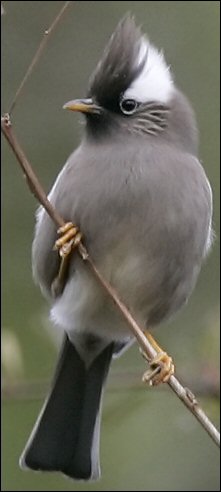Shaanxi Province

Birding Shaanxi
China possesses a huge diversity of bird life, largely attributed to the varied physical landscape and ecological conditions seen over it’s vast territory. Hengduanshan, Qinlingshan, and Huaihe basically divides China into northern and southern regions, helping to create a country that has large areas of wetlands, salt marshes, mountains ranges, deserts, plateaus, forests, alpine meadows, and grasslands. Such areas create ideal habitats for many different species of residing, breeding, migrating and wintering birdlife.
The Shaanxi Province is located in central China and covers an area of 205,600km2. The provincial capital is Xi’An, often thought to be the cradle of Chinese civilisation. It is most famous for the Terracotta Warriors, uncovered by local farmers (1974) and considered to be one of the most important archaeological discoveries in recent history.Shaanxi is located within both the temperate and subtropical zones, and shows great climatic differences between the areas north and south of the Qinling range. The province can be divided into three geographic (and hence climatic) terrains, the northern loess plateau, the middle Guanzhong plain, and the southern Qinba mountainous area. The northern loess plateau is the middle area of the Loess Plateau and covers most of northern Shaanxi. The Guanzhong Plain (also known as the Weihe Plain) was formed by the alleviation of the Wei River, the largest branch of the Yellow River. The plain begins in Baoji in the west and ends at the Yellow River in the East. The Qinba Mountain area includes the Qinling and Daba ranges, with the Hanshui valley between them. The Qinling Mountains are the most significant geographical formation in the Shaanxi Province, and the only area in China that functions as a watershed for the country’s two most significant rivers, the Yangtze River and the Yellow River. The Qinling Mountains run from west to east and cover more than 52,000km2, forming the natural division between northern and southern China (and the Shaanxi Province) in terms of geography and climate. This mountain range is also very important as it is the northernmost distribution area for the giant panda and is also one of the areas with the densest panda population.
The Mountains are ecologically significant, dividing the province and reaching elevations of almost 3800m. Such dramatic elevational changes, have led to equally dramatic changes in the flora and fauna in different regions, with this area being home to the most biologically rich temperate forests in the world. The peaks of the Qinling Mountains form a barrier to the cold dry northern air (coming from Inner Mongolia), allowing warm rain and flourishing growth on the broad southern slopes. Due to this and the large elevational changes, a huge diversity of plant and animal life exist on the southern Qinling slopes (including giant panda, golden monkey, golden takin, golden eagle, and crested ibis – all first class protected species).
-
Hongjiannao - Yulin Prefecture
InformationSatellite ViewHongjiannao can be found in the Yulin Prefecture, in the northwest of the Shaanxi Province. It is considered to one of China’s largest desert lakes and is a haven for aquatic birds. It is home to at least 26 species of bird that currently have second class state protection. -
NNR Changqing, Yangxian County, Hanzhong Prefecture
InformationSatellite ViewMany areas of the Qinling Mountains are now designated National Nature Reserves, often made so in an effort to converse giant panda habitat and other endangered species. With this protection many other plants and animals have benefited, including the crested ibis Nipponia Nippon, one of the most endangered bird species in the world. Due to captive breeding and release programs at Louguan Tai and Yangxian, this species has been brought back from the brink of extinction and can now be seen in the wild in Changqing National Nature Reserve. This reserve is one of the best places to view wildlife, and birdlife, in the Shaanxi Province.Changqing National Nature Reserve is located on the southern slopes of the Qinling Mountains, in south-west Shaanxi about 300 km south of Xi’An city. The Reserve is almost 30,000 hectares in size and its highest peak reaches 3100m. It is one of the most important ecological areas and broadleaf temperate forests in China, providing one of the best and last remaining places where giant panda, golden takin, golden monkey and crested ibis can be found in the wild. It is also home to 39 other threatened animals and 31 threatened plants.Changqing Reserve is one of the best places for birding in the Shaanxi Province, and it has 154 species of birds living within its boundaries, 17 of which are endangered. A further 176 species, 13 endangered, are found in the rural area just outside the Reserve. Some species that can be seen in the reserve and surrounding rural landscape include the golden eagle Aquila chrysaetos, golden pheasant Chrysolophus pictus, blood pheasant Ithaginis cruentus, Temminck's tragopan Tragopan temminckii, Chinese bamboo partridge Bambusicola thoracica, sooty tit Aegithalos fuliginosus, vinaceous rosefinch Carpodacus vinaceus, laughing thrushes, parrotbills, collared finchbill Spizixos semitorques, and the crested ibis Nipponia nippon, which can be seen both in the wild at Changqing and at a captive breeding centre in Yangxian County. -
NP Qiachuan, Heyang County, Weinan Prefecture
Satellite ViewQiachuan National Park is located in the Weinan Prefecture and has been listed as a provincial scenic and historic spot since 1995. This lake area contains remnants of ancient cultures that thrived along the Yellow river and its tributaries, and covers a total area of 110km2. It has abundant water birdlife, particularly noted for its aquatic migratory bird watching. -
NR Huanglong, Yanan Prefecture
InformationSatellite ViewHuanglongshan Nature Reserve is located in north-central Shaanxi in the Yanan Prefecture, and ranges in elevation from 620m to 1783m. It was established in 2003 in an effort to protect a population of Brown Eared Pheasant Crossoptilon mantchuricum, a species endemic to northern China, which was discovered there in 1998. The distribution of this species relates to a band of temperate broadleaf-conifer forest that extends through Shanxi, Beijing, northern Hebei, and westwards into central Shaanxi. -
Taibaishan - Taibai County, Baoji Prefecture
WikiSatellite ViewTaibaishan reserve is located on the northern slopes of the Qinling Mountains, and shares borders with Taibai, Mei, and Zhouzhi Counties. It was declared a National Reserve in 1986, and covers an area of 56,325 hectares, with its highest peak (Taibai Mountain) reaching an elevation of 3,767m.The reserve is mostly mountain forest and grassland, and provides habitat for 1,550 species of wild plants, 192 wild birds, and 62 species of animals. It is home to endangered and vulnerable bird species, including the rufous-headed robin (Luscinia ruficeps) and the black-throated blue robin (Luscinia obscura). Other species which can be located at Taibaishan include Temminck's tragopan, blood pheasant, golden pheasant, Fujian Niltava, Sichuan treecreeper and orange-flanked and golden bush-robins.
-
Number of bird species: 515
(As at April 2020)
-
IBA Hongjiannao Lake
InformationSatellite ViewHongjiannao Lake is China's largest "desert freshwater lake" which is located on the border of Shaanxi Province's Yulin City and Inner Mongolia's Ordos City . The lake is the largest inner land fresh lake of Shaanxi and honored as 'Shining Pearl in Sand Sea'. Up to 5,000 pairs of the endangered Relic Gulls breed there. -
NNR Changqing
InformationSatellite ViewThis mountainous reserve is most famous for its Crested ibis Nipponia nippon and mammals such as Giant panda, Golden monkey & Golden takin. -
NNR Foping
InformationSatellite ViewThe Foping Reserve covers 29,240 hectares (72,300 acres) of rugged mountain terrain and is home to a stable panda population. Elevations range from 1,080 to 2,094 m with warm summers and cold winters. 950–1,200 mm of rain falls mostly from July to September, with snow at higher elevations. Forested lands dominate the reserve with a mix of conifers and broadleaf deciduous trees. Mammals found in the reserve include the giant panda, golden monkey, mainland serow, Chinese goral, dwarf musk deer, Asiatic black bear, and North-Chinese leopard. Also red and white giant flying squirrel lives in the reserve. -
NNR Taibai Mountain
InformationSatellite ViewLocated at the juncture of Taibai, Mei and Zhouzhi counties of Shaanxi Province, Taibai Mountain Nature Reserve was established in 1986 with an area of 56,325 hectares. The flora and fauna of Taibai are quite diverse, with species from both northern and southern Chinese environments uniquely coexisting in the region. -
NP Qiachuan
WebpageSatellite ViewIt has abundant water birdlife, particularly noted for its aquatic migratory bird watching. -
NR Huanglong
InformationSatellite ViewThe total length of the travertine in Huanglong Valley is 3.6 km and it is thought to look like a huge golden dragon wheeling through the snow-capped mountains of the valley.
-
Alpine Birding
Tour OperatorBirding trips here are made for avid birders including yearly-run trips and new China birding trips developed by AlpineBirding team and guided by our bird experts in the best
-
2013 [06 June] - Max Berlijn
PDF ReportAnnotated list… -
2018 [04 April] - Mark Smiles - Beijing, Shaanxi & Sichuan
PDF ReportThis was a trip with my wife aimed at visiting the main Chinese cultural sites and a return to Sichuan, a province I’d had a taste of in May 2015 when I visited with t wo birding friends from the UAE. Although a little early for most of the returning migrants (most of which I’d previously seen in 2015 ), the timing of this trip proved very successful for certain species (esp ecially pheasants & tit - warblers) which become trickier late on.

